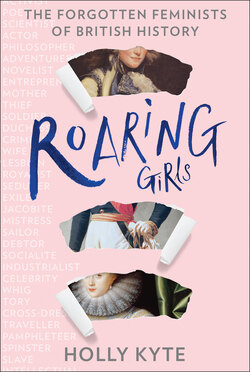Читать книгу Roaring Girls - Holly Kyte - Страница 22
MAD MADGE
ОглавлениеSamuel Pepys had been trying to catch a glimpse of the famous Duchess of Newcastle for weeks. It was spring 1667, the lady was in London on a rare visit from the Midlands and everyone was impatient for a sighting. The rumours had it that she would visit Charles II’s court on 11 April, and in the private pages of his diary, Pepys was on tenterhooks: ‘The whole story of this lady is a romance, and all she doth is romantic. Her footmen in velvet coats, and herself in an antique dress … There is as much expectation of her coming to court … as if it were the Queen of Sweden.’[1] So, along with the curious, of which there were many, to Whitehall Pepys went – only to leave disappointed, for the Duchess never appeared.
A fortnight later, on 26 April, he spied her distinctive black-and-silver coach and velvety footmen as he was travelling through London. He craned and peered and saw just enough to conclude that she was ‘a very comely woman’, dressed just as the gossips had described: velvet cap, mannish black juste-au-corps riding jacket, hair covering her ears, neck bared and a number of fashionable black patches scattered over her face.
This little snapshot wasn’t nearly enough to satisfy Pepys, so come 1 May he hastened to Hyde Park where she would be riding out along with the rest of the court in the May Day parade. Unfortunately, everyone else had the same idea, and the Duchess was so ‘followed and crowded upon by coaches all the way she went, that nobody could come near her’.
On 10 May they had another brief encounter as the Duchess made her way home through town to Newcastle House, in Clerkenwell. Spotting her carriage ahead of him, Pepys drove furiously in the hope of overtaking her, only to be thwarted yet again by a horde of ‘100 boys and girls running looking upon her’ who were also desperate for a peek. In the end, she arrived home before Pepys could catch up with her, but he wasn’t discouraged. ‘I will get a time to see her,’ he pronounced confidently.
And eventually, on 30 May, he did. The Duchess had boldly requested, and been granted, an invitation to the newly formed Royal Society – a Restoration temple to scientific advancement – and Samuel Pepys happened to be a member. There had been ‘much debate, pro and con’ by the fellows about whether or not a woman should be admitted at all. It had never happened before, and many were against it, some arguing that the Duchess’s reputation would expose the Society to ridicule, others that it surely set an undesirable precedent. But at length the motion was carried, the lady invited – and a fuss expected. ‘We do believe the town will be full of ballads of it,’ Pepys noted, and when the day came, he hurried to the Society’s headquarters, where he found ‘much company, indeed very much company, in expectation of the Duchess’, just like him.
At long last, Pepys had his chance to critique the woman at close quarters, and afterwards, as was his habit, he shared his impressions with his diary. His verdict, after all that, was damning:
The Duchess hath been a good comely woman; but her dress so antique, and her deportment so unordinary, that I do not like her at all, nor did I hear her say anything that was worth hearing, but that she was full of admiration, all admiration.
This lady, supposedly so learned in natural philosophy, had been shown the Society’s most innovative new experiments – ‘of colours, loadstones, microscopes, and of liquors’ – yet she’d had no insights or observations to offer whatsoever. In fact, she’d been virtually speechless. It had all been a great disappointment.[2]
Not many women could inspire such fascination on the one hand, and such scorn on the other. John Evelyn was also present that day and his diary entry was more succinct but no less scathing: ‘To London, to wait on the Duchess of Newcastle (who was a mighty pretender to learning, poetry, and philosophy, and had in both published divers books) to the Royal Society, whither she came in great pomp.’[3] And there was the truth of it: Margaret Cavendish, Duchess of Newcastle, had trespassed on male ground. She was a ‘mighty pretender’ to scientific and philosophical learning, who’d had the temerity to publish her writings, cultivate her own eccentric style and wilfully make a spectacle of herself. Every man in that room was thinking it: How dare she?
